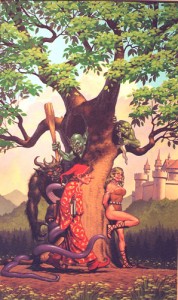
That’s right, I have never laid eyes on him, nor have I ever spoken to him on the phone (nor, to my knowledge has anyone else who owns his art). But that’s ok. Walter is the kind of guy who prefers to deal with the world only through one person, and when it is his agent of 35 years (and counting, I respect that. Plus, who would want to invade the privacy of a guy who says things like, “For the past 20 years I’ve been able to concentrate on improving the quality of my painting techniques rather than just meeting deadlines.”

Not that Walter has completely stopped working. He recently finished the cover art for Gygax Magazine, and he’s currently working on a tarot deck with art based on Bronze Age Greek Mythology, a subject that must be close to his heart because Walter spends his summers at a home he’s built on Crete (and see his self portrait!).
Another thing that these two artists share is that they started their art professional illustrative careers at approximately the same time (1978); and had by the ‘hey-day’ of the 1980s solidified their popularity and success in the literary market by demonstrating something that cannot be taught: a signature style of expression.
Through paperback covers for Ace Books, for the Thieves World series (one of the most popular series in science fiction publishing history)—and Robert Asprin’s Myth series, starting 1981, Walter achieved recognition—because these book covers captured what fans found so special about his work. Which explains why Walter was still working on the long-lived Myth series in 2004.

Many fans of sf/f art look back at artists who were producing cover art during the 1980s as belonging to a special, almost “elite” group. Not only were their styles of expression wholly original and ideosyncratic—as varied, in fact, as you could get in a field (commercial art) not notable for encouraging originality—but they were able to carve out careers working by working in those distinctive styles. Art directors who hired artists like Walter Velez and Jill Bauman (and Darrell K. Sweet, Tom Kidd, James Warhola, David Mattingly, Barclay Shaw, Ron Walotsky . . . .the list is long) knew exactly what they were going to get. They were going to get a “Velez”—an image that was as distinctive in style as it was memorable. Indeed, they counted on artists’ “signature styles” to sell books. Especially trilogies, and SERIES of books.
There was a warmth to Walter’s style, an intensity belied by touches of whimsy, that set his illustrations apart. This kind of charm, this kind of fun, is what made alot of art from the 1980s, despite its seeming surface simplicity, so persuasive as a marketing tool. It had strong, visual concepts, it “involved” the viewer in ways that no photoshopped image of today, does. Can you see that? Can you feel that?
The bulk of Walter’s work since 1980 has been in sf/f book covers, for publishers such as Berkley, Doublleday, Tor, Easton Press, DAW and others as well as genre magazines. But he also illustrated children’s books, created cover art for RCA video discs (before DVD’s!) and record album sleeves for various labels, including Columbia Masterworks. Over the years, he says, he never really changed markets, he just “expanded them.” Which is how he came to be hired for Batman & Joker candy box cover art, and baseball cards (for Topps,1989), and Goosebumps Trading cards (Topps, 1996).

Yet, the very same strengths that made painters with unique styles so successful, also made them vulnerable when publishers turned “conservative” in the 1990s. The economic downturn in the early 90s, which affected book publishing, pushed many artists into the game industry . . . and Velez joined them.
Working for TSR™, Walter jumped into game art with a noticeable splash, producing a range of paintings for AD&D™ products (1994-1999) as well as for companies like Iron Crown, West End Games and art for collectible card games like Dune and Star Trek (Last Unicorn Games, 1997) and Mythos (Chaosium, 1997).

Then came the transition to digital technologies, which revolutionized the process of creating illustrative art. And with it, an opportunity for artists like Velez to turn to fine art, and taking on commissions that permitted more freedom to experiment. Walter, for example, is working on the art and design for a book cover for a Spanish language book of poetry, as well as creating surrealistic paintings that have very little in common, stylistically, with his illustrative art. And he of course continues to sell his art to private collectors in the U.S. and Europe.
As he says, “I have many ideas for new projects, but they need refining and planning before I start them. Art to me is a lifestyle not just an occupation.” Don’t you love reading that?
Check out his website at: www.waltervelezart.com.










This is a wonderful article! Thank you so much for your research. This allows me to recognize an artist who made a big impact on my life—I adored these covers as a kid, and can appreciate them even more now that I have read this.